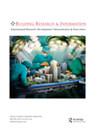基于创新扩散理论的我国建筑设计采用交叉层压木材降低内含碳排放
IF 3.7
3区 工程技术
Q1 CONSTRUCTION & BUILDING TECHNOLOGY
引用次数: 1
摘要
交叉层压木材(CLT)是一种准刚性复合工程木材产品,可以帮助建筑行业减少隐含碳排放。CLT在建筑设计中的应用对于实现中国的双碳目标具有重要意义。本研究旨在了解影响建筑师采用这种低碳建筑技术意愿的因素及其影响。运用创新扩散理论(DOI),结合建筑师的创新性和交叉层合木材的材料特性,采用偏最小二乘结构方程模型(PLS-SEM)构建采用模型。发现CLT的采用取决于建筑师的新颖性和独立判断,以及可试验性、可观察性、相对优势和风险。可观察性对使用交叉层压木材的意向影响最大,其次是可试验性、风险和相对优势。当务之急是增加设计专业人员观察和体验CLT的程度,增加其好处的宣传,并解决吸收的障碍。不同工作经验的建筑师之间存在显著差异,这将有助于制定量身定制的策略,更好地在中国推广交叉层压木材。本文章由计算机程序翻译,如有差异,请以英文原文为准。
Adopting cross-laminated timber in architectural design to reduce embodied carbon emission in China based on the diffusion of innovation theory
ABSTRACT Cross-Laminated Timber (CLT) is a quasi-rigid composite engineered timber product that can assist the building industry in reducing embodied carbon emissions. The adoption of CLT in architectural design is of great importance to help to achieve China’s dual carbon goals. This study aims to understand the factors and their effects on influencing architects’ intentions to adopt this low-carbon building technology. It applied the theory of diffusion of innovation (DOI), incorporated architects’ innovativeness and material properties of cross-laminated timber and used partial least squares structural equation modelling (PLS-SEM) to construct an adoption model. The adoption of CLT was found to depend on architects’ novelty seeking and independent judgement making as well as the trialability, observability, relative advantage and riskiness. Observability had the most significant impact on the intention to use cross-laminated timber, followed by trialability, riskiness and relative advantage. It is imperative to increase the extent to which CLT can be observed and experienced by design professionals, to increase the publicity of its benefits, and to address barriers to uptake. Significant differences were found between architects with different years of work experience, which will help to develop tailored strategies for better promoting cross-laminated timber in China.
求助全文
通过发布文献求助,成功后即可免费获取论文全文。
去求助
来源期刊

Building Research and Information
工程技术-结构与建筑技术
CiteScore
8.60
自引率
7.70%
发文量
43
审稿时长
>12 weeks
期刊介绍:
BUILDING RESEARCH & INFORMATION (BRI) is a leading international refereed journal focussed on buildings and their supporting systems. Unique to BRI is a focus on a holistic, transdisciplinary approach to buildings and the complexity of issues involving the built environment with other systems over the course of their life: planning, briefing, design, construction, occupation and use, property exchange and evaluation, maintenance, alteration and end of life. Published articles provide conceptual and evidence-based approaches which reflect the complexity and linkages between cultural, environmental, economic, social, organisational, quality of life, health, well-being, design and engineering of the built environment.
 求助内容:
求助内容: 应助结果提醒方式:
应助结果提醒方式:


